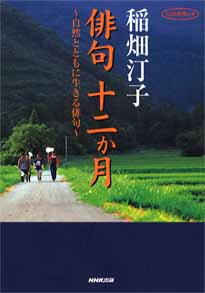NATURE AND OUR LIFE
--- Haiku Living Together with Nature ---
From the book entitled "Haiku in Twelve Months"
Authored by Ms. Inahata Teiko.
Translated by Mizuta Mutsumi
|
|
 November――Feeling of Drizzling November――Feeling of Drizzling
Winter comes after the day of ritto which falls on about November the 8th (the first day of winter in the traditional calendar). This time of the year, which is called early winter, is a good season, because the winter air braces our mind and body and we have Indian summer days during these days. While we still enjoy the feeling of autumn, the nature surely begins to change to winter. There is a clear, quiet and lonely atmosphere in the air of the mountains, rivers, trees and plants, and the sounds of rain and wind. We feel the more when we have the first frost or the first of drizzling rain of winter season.
In the meantime, when red and yellow leaves begin to fall, falling leaves are constantly scattered on the ground and still more a withering blast begins to blow, people become busy preparing for the arrival of real winter. The characters of this season are shown in the seasonal words such as daikon arau (wash the radishes), daikon hosu (dry the radishes under the Sun), kiriboshi (dried strips of the radishes) and takuan tsuku (pickle the radishes). People have lived with poetic feelings in their lives. Furthermore such seasonal words as kitamado fusagu (close the north windows), mebari (tape the windows), kazayoke (guard the house from the wind), fuyugamae (getting ready for coldness) describe the lives in winter.
But we believe that among those seasonal words, shigure (a drizzling shower in early winter) is the most typical seasonal word, which exactly depict the sceneries and atmosphere in early winter. In October in the lunar calendar it often rains on and off, and therefore it is called the month of drizzling rain. Shigure, raining on and off, has been composed in a delicate way in poems from the time of Waka of Shinkokin as a symbol of changeable things, the transience of human life. This sense of transience, the original idea of shigure , has been inherited to haikai. But in haikai , "the Danrin school (a school of haikai which became popular in the latter half of the 17th century. It opposed the traditional haikai of the Teitoku school and composed haiku with innovative and novel interests and wrote comical idea in light and easy spoken language) made intentionally fun the original purpose and ended in comicality. However, it can be said that their innovative composition was still placed under the restriction of tradition in spite of their attempt.
In the book of "Sarumino" written by Basho, shigure came to be freely composed in haiku apart from the restriction of original meaning of the season. In the book of "Sarumino" there are thirteen poems of haiku composed with a theme of sigure.
When in 1936, Takahama Toshio (the son of Kyoshi) began to read "Sarumino" in turn with Nara Shikaro, Awano Seiho and others, Takahama Kyoshi encouraged them by sending a telegram, which reads:
"Begin with thirteen poems of haiku with a subject of sigure". Maybe he meant that they should study the seasonal word, shigure which was composed freely in "Sarumino" apart from original intention of waka poems.
How is shigure composed in haiku in modern times?
|
|